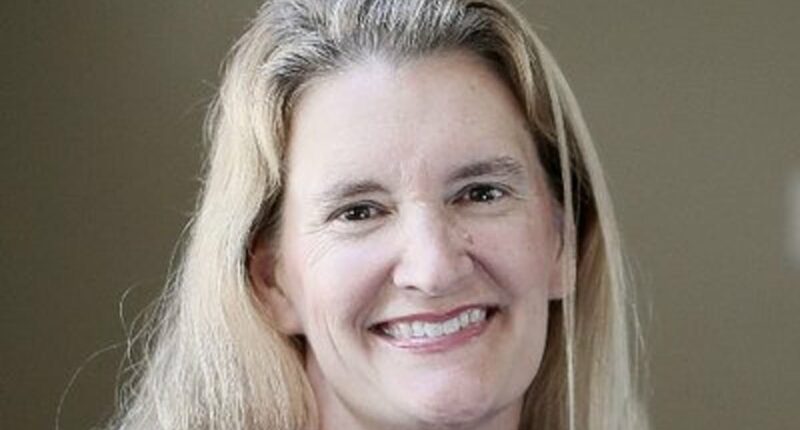Share this @internewscast.com
For the past ten years, America has been embroiled in debates over transgender issues, from the participation of men in women’s sports to controversies surrounding pronoun usage.
However, this intense focus appears to be waning.
Recent analysis indicates a significant decline in the number of young people identifying as transgender or nonbinary over recent years.
The data reveals that the proportion of 18 to 22-year-olds identifying as transgender has nearly halved, dropping from approximately six percent at its peak in 2022 to about three percent in 2024.
Similarly, the percentage of young adults identifying as nonbinary has fallen sharply within just one year, decreasing from around five percent in 2023 to roughly two percent in 2024.
These findings surprised even experts like Professor Jean Twenge, a psychologist from San Diego State University who has dedicated decades to studying gender identity trends.
She told the Daily Mail: ‘I was surprised… just because in previous trends, transgender identity had steadily been increasing… It was a surprising turnaround.’
Twenge decided to conduct her analysis after Vancouver-based politics professor Eric Kaufmann sparked controversy last week with claims that ‘trans identification is in free fall among the young.’

Psychologist Jean Twenge, a San Diego State University professor and author of Generations, discussed the data with the Daily Mail
His post, which Elon Musk and Don Jr. reshared, caught flak from critics who noted his figures reflected only nonbinary respondents.
They also called into question how the data was weighted to reflect the broader population beyond the sample size.
He used numbers from the Foundation for Individual Rights and Expression (FIRE), which polled more than 60,000 American college students from 2016 to 2025 ‘not identifying as either male or female.’
‘The problem, as I knew from looking at the data weights, was that they produced erratic results,’ Kaufmann reflected on where his data analysis went wrong.
The confusion inspired Twenge to investigate whether Kaufmann’s statement that transgenderism was declining could be corroborated with accurate data.
She turned to data from the Cooperative Election Study (CES) — the largest academic survey focused on American elections.
Focusing on the 18 to 22-year-old group, she said she evaluated the roughly 2,000 responses the study has received from this age range each time it is conducted.
The CES, primarily coordinated by Tufts University and administered by polling group YouGov, has collected data from more than 50,000 Americans every election year since 2006.
The FIRE has ‘become the nation’s leading defender of fundamental rights on college campuses’ and has a free speech-focused mission.

Last week, professor Eric Kaufmann (pictured) sparked a heated debate when he cited the Foundation for Individual Rights and Expression (FIRE) to point to a decline in transgenderism among the demographic

‘NEW: trans identification is in free fall among the young,’ he wrote on X alongside a chart depicting the ‘share of students not identifying as male or female, 2016-2025’
Twenge, who recently published a book called Generations, examining identity and cultural shifts among Gen Z, went into the analysis with an open mind.
‘I always try to be as objective as possible,’ she told the Daily Mail. ‘I am doing my very best to see this as a researcher and not in a political lens.’
‘It turns out identifying as transgender really is in free fall among the young in the US. So is identifying as nonbinary,’ Twenge wrote on Substack, where she shared her CES data analysis.
‘In other words, Kaufmann was right (with what some consider the wrong data, but still right).’
Kaufmann told the Daily Mail: ‘Twenge is arguably the leading authority on youth social trends, especially in America.
‘Her results showed what I believed to be the case but lacked precise data on: that binary and non-binary trans identity trends move together over time.’
Twenge cautioned, however, that ‘we won’t really know for sure’ if the reduction observed is permanent until 2025 data becomes available.
While there is no single explanation for the shift, Twenge believes social and political factors could be at play.
‘If greater acceptance led to the increase, a decline in acceptance could have led to the decrease,’ she said.
‘The national conversation in the US around transgender identity shifted in the last few years.’
From sports to bathrooms, transgenderism in America has become a controversial topic in recent years.

Billy Burleigh (pictured when he transitioned to a woman) said transitioning took him about seven years

Burleigh (pictured after his de-transition) said the trends could reflect people also choosing to de-transition
Under Donald Trump’s administration, gender-affirming healthcare has been limited and transgender people have been banned from joining the military.
The controversy spans beyond the US, with the UK Supreme Court ruling there are only two genders.
Individuals who have de-transitioned told the Mail that the new downward trends reflect a broader phenomenon.
Billy Burleigh, 58, and Prisha Mosley, 28, both transitioned when they were young — a process they described as grueling and traumatizing — before later returning to their biological genders.
‘It’s a social contagion, and we can see that reflected in the data,’ Mosley, who was born female, said as she tended to her 16-month-old baby in North Carolina.
‘If we look at data on things like anorexia or bulimia, or girls and boys who cut themselves in high school – those trends have had an uptick and a downtick in the same way.
‘But the only difference with this trend is that medical professionals got involved to make it permanent.’
Mosley, who began her transition to become a male as a teen behind her parents’ backs and received a double mastectomy at 18 years old, said social media played a role in encouraging people to change their gender identities.

Mosley (pictured when she transitioned to a male) said social media has played a role in encouraging people to change their gender identities

Prisha Mosley (pictured after her de-transition) began her transition to become a male as a teen behind her parents’ backs and received a double mastectomy at 18 years old
She believes the decline from 2022 to 2024 is because ‘people are seeing a lack of results’ and ‘are starting to wake up.’
‘Tons of adults went through a goth phase, but doctors didn’t come and tattoo black lipstick on their face.’ Mosley noted.
Burleigh, of Louisiana, had a similar reaction to the recent findings.
‘It could be that a number of those people that have identified as transgender are realizing that this has not resolved their needs for acceptance, significance and security,’ he said.
Burleigh, who said he began transitioning into a female in his 20s, said the process took him about seven years.
‘At the end, I actually had more problems than when I started,’ he said.
He described experiencing ‘excessive bleeding’ and other complications following bottom surgery — a procedure designed to create the opposite sex’s genitals.
During his de-transition, he underwent a phalloplasty to reconstruct his penis.
‘That was the absolute worst and most painful surgery,’ he recalled. ‘And I try to share this with people — none of the surgeries are working.’
He speculated that the growing number of people choosing to de-transition ‘could be contributing to this downward trend we are seeing.’

















